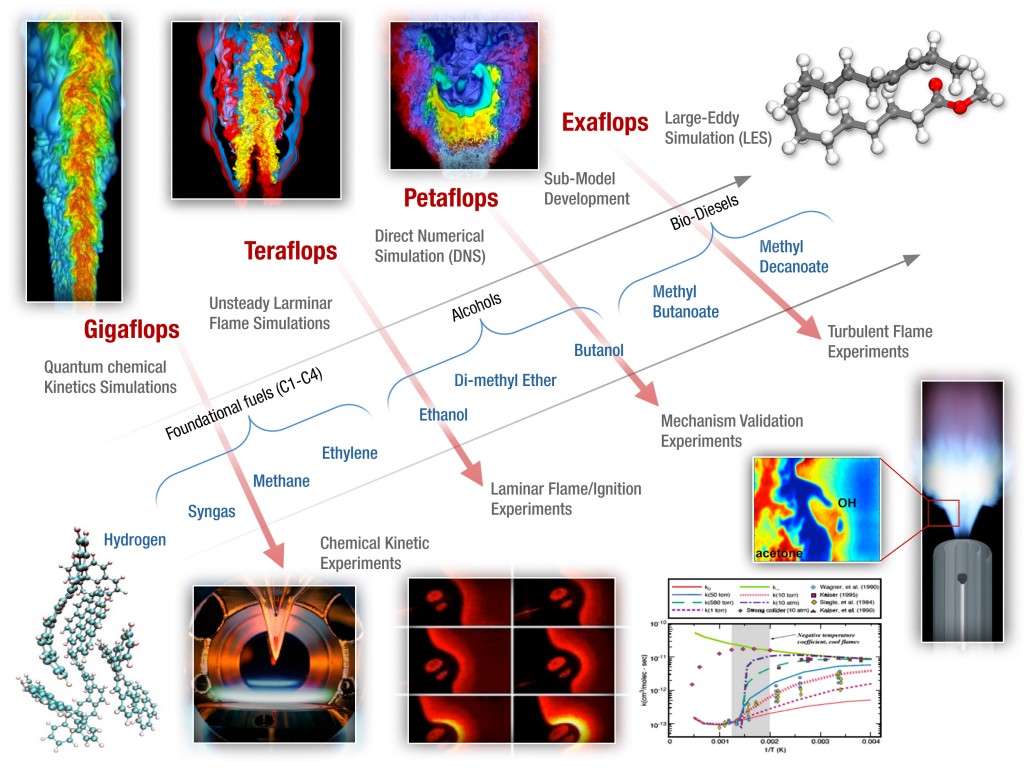The Challenge
The Solution
Due to power constraints, computing at the exascale will require extreme levels of parallelism – as much as billion way concurrency – requiring revolutionary software and hardware technologies that have to be optimized for performance, power, energy, and reliability. Applications co-design of the entire stack, including combustion applications, programming models, scientific data management and in situ analytics, runtime systems, and hardware is needed to design solution stacks that are dynamic, power efficient, as well as resilient to software and hardware faults. A key part of ExaCT, therefore, is to tailor the system so that its strengths are tuned to needs unique to combustion research. This type of approach is intended to be highly iterative—as researchers design new architectures, proxy applications of key aspects of a combustion simulation will be run in an architectural simulator with an abstract machine model, representing potential characteristics of an exascale architecture, to see if a hypothetical system is well suited to study the scenario at hand.
ExaCT will use proxy applications (apps), which are smaller code fragments that represent an important functionality in a production code, to represent the combustion application workload and requirements to the exascale ecosystem. Through architectural simulation of future exascale designs represented by an abstract machine model, the proxy apps will be used by both high performance computing vendors and the co-design team to understand the effects of hardware tradeoffs and to explore new programming languages and models, algorithms and technologies. The proxy apps will evolve significantly through the iterative co-design process.
The power requirements of combustion codes depend on voltage and frequency; reducing both will require flat or reduced clock frequencies. Additionally, the energy cost of data movement may exceed the cost of computation, implying the need for stricter control of data locality in the newer architectures. Software codes for conducting simulations will also have to be designed to adapt to emerging hardware trends. For example, in combustion codes, novel algorithms for numerical discretization of partial differential equations solving the reacting Navier-Stokes equations are required to express significantly greater concurrency, and potentially trade increased computational intensity for reduced data movement. To access relevant high pressure regimes of combustion, the methodology will combine high-order accurate discretization with adaptive mesh refinement.
Beyond simply performing an exascale combustion simulation, additional challenges arise in the end-to-end problem. The traditional approach used in the combustion community for scientific data management, analysis and visualization is to periodically write synchronous checkpoints to persistent storage for restarts and analytics. This approach becomes infeasible at the exascale because I/O speeds will significantly lag behind compute speeds, and the total amount of data stored for post processing must be reduced even as the simulations get increasingly detailed. To address these technology constraints, ExaCT will develop the capability to analyze and visualize simulation results in situ as part of the simulation process by enabling combustion scientists to choose aspects of the simulation to measure and instrument the code to extract those measurements. Co-design research in programming models, runtime systems, and resiliency are also needed to perform in situ data analytics.
Says Dr. Chen, “Successful co-design will enable exascale combustion simulations to advance the science base that will ultimately contribute to development of non-petroleum-based fuels and their efficient utilization, crucial to the goal of reducing US dependence on petroleum usage.”
